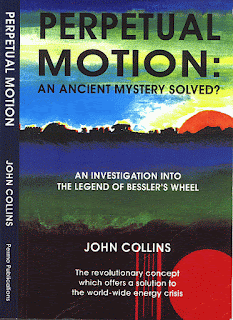I hope everyone had a Merry Christmas, we certainly did, and the New Year 2022, looks like being the best ever, when the secret of Bessler’s wheel is revealed.
It is easy to forget why we are all still believers in Bessler’s claim to have invented a perpetual motion machine. Yes, we are all familiar with Bessler’s words and the witness statements, but what evidence is there against his perpetual motion machine? One - they are said to be impossible, but that only applies to isolated systems with no external source of energy. The second piece of evidence is that of Bessler’s maid.
I have copied and pasted a paragraph from my book about Bessler, published in 1996!
‘In a document dated 28th November 1727, Orffyreus' maid makes the following statement, as recorded by Strieder:
"The posts had been hollowed out and contained a long thin piece of iron with a barb at the bottom which was attached to the shaft journal. Turning was carried out from Orffyreus' bedroom which was close to the machine, on a shelf behind the bed."
The first area of concern was the statement that the maid made concerning the secret mechanism. It was frankly, impossible. Whatever mechanism moved that wheel, there is absolutely no way that it could be driven by the means described. Twelve feet across or 3.6 metres - eighteen inches thick or 45.7 centimetres and weighing an estimated 700 lbs or 318 Kilograms, and the whole construction turned on a pair of bearings measuring just three-quarters of an inch! And what is more, accelerated from a very slow speed to one of between twenty-five and twenty-six revolutions per minute, in just three revolutions. The maid says that the posts were hollowed out and a barbed piece of iron inserted and connected to the shaft journal. Anyone giving reasonable consideration to this account of the maid's, will see that the power and strength required to keep a machine of this size turning, by applying its force through the bearings, would be enormous - and besides where would one find a metal of sufficient strength to withstand the tremendous load placed on it. Not only that - it had to be kept turning for almost eight weeks - and was expected do work; raise a box of bricks weighing seventy pounds and turn an Archimedean screw. Forget the problem of actually devising a mechanism which would operate inside a wooden post connected to a bearing at one end and a small wheel at the other!
Bessler’s wife had died in 1726 and only a few months later on the 28th November 1727, the maid accused Bessler of fraud, this was shortly after Karl retired and although removing his patronage he gave Bessler the use of a house and garden in Karlshafen. He also dismissed the maid’s accusations. He advanced Bessler five years salary to enable him to continue to develop and sell his wheel. This marked the end of Karl’s protection against the slanderous publications of his enemies, Gärtner, Wagner and Borlach. They grabbed the opportunity to lambast Bessler and his wheels with enthusiasm, driven by either jealousy or indignation.
The maid, Anne Rosine, from Mauersberg, a town less than 5 miles from Bessler’s father-in-law had been brought to Hesse Kassel, by Bessler and his new wife, as agreed between Bessler and his future father-in-law. She had been a constant thorn in the side of the mayor and chief physician of Annaberg-Bucholz, Dr Christian Schumann. He had had her imprisoned twice for spreading malicious gossip about him and his family.
Christian Schumann agreed to the marriage as long as Bessler took the troublesome maid with him to Gera, some one hundred miles away in those days, plus of course a dowry.
The maid was often seen about the Landgrave’s court as witnessed by one of the female courtiers and it is possible that she met with Christian Wagner and/or Gärtner. Although Gärtner died in February of that same year 1727, he may have been the guiding force trying to out Bessler as a fraud.
As soon as he moved out of the castle and took up residence at Karlshafen, Bessler’s wife’s mother, now a widow with no money, suddenly arrived with her two other daughters and son-in-laws. They joined forces with Bessler’s erstwhile maid and began to try to extort money and favours from him. Suddenly out of Karl’s protection and being harassed by a small family of criminals, Bessler soon lost all of his money to their controlling and coercive behaviour.
So two pieces of evidence against Bessler and both deeply flawed.
JC








